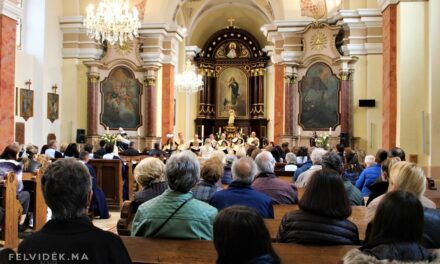The well-known noise of the bus tour, the roar of the crowd, and the cheerfulness of the people around the world symbolize the vitality of our values.
The enormous popularity of the bus tour is due to the communities that follow their traditions, i.e. "consciously guarding the flame", stated the state secretary responsible for culture of the Ministry of Culture and Innovation (KIM) in Mohács, during the event's main program on Sunday.
Magdolna Závogyán drew attention to the fact that - although ritual winter practices can be found in many variations throughout Europe - the folk customs of the Croatian ethnic group of Mohács, the Sokács, are unique.
He said that the "combination of the customs of peoples living as brothers has matured an unparalleled cultural richness" in the image of the Busójárás, which is also proven by the fact that UNESCO included the folk custom on the international representative list of the intellectual cultural heritage of humanity, which is already part of the collection of Hungarian heritage.
He declared: all this is a community success "in space and time". Just as there is no doubt that "the enormous popularity of busójárás is the merit of those communities that consciously build and guard the flame".
The preparation itself becomes a part of the culture during the bus tour, as the planning and making of the masks and costumes, the authentic appearance requires effort and organized, persistent work from the members of the groups, the preparation is serious ethnographic research work, and the making of the props is an outstanding craft and even artistic achievement .
The well-known noise of the bus tour, the roar of the crowd, and the cheerfulness of the people around the world symbolize the vitality of our values , stated Magdolna Závogyán, before concluding her speech by wishing the participants a successful winter drive.
Before the State Secretary's speech, a new bus was inaugurated with the help of the politician and mayor Gábor Pávkovics (Fidesz-KDNP), and then a free carnival began in downtown Mohács with the participation of tens of thousands of local residents and visitors.
The popularity of the Mohács folk custom is steadily increasing: according to the organizers' estimates, more than a hundred thousand people will participate in this year's bus , which began on Thursday and will last until February 13 , and 40-45 thousand on the busier days. This year, a record number of 71 bus groups and 2,500 masked people will entertain those interested, and visitors can participate in 160 programs at 15 locations.
The famous carnival event, which was settled by the Sokác ethnic group, was mentioned for the first time in a record from 1783.
According to a legend among the ethnic group that settled around Mohács during the Turkish subjugation from the Balkan region, their cunning ancestors fled from the Turkish occupation to Mohács Island on the other side of the Danube. The sokacs came back after crossing the river wearing disguises and raided the superstitious Turks, who fled the city in a panic, terrified by the scary masks.
The traditional elements of winter hunting and spring greeting folk customs have remained unchanged for centuries: adults dressed in badger fur coats, linen coats, boskors, with carved masks and equipped with characteristic props - knapsacks, maces, lap clappers and columns - say goodbye to the harsh season and await spring.
In 2009, the UNESCO Educational, Scientific and Cultural Organization of the United Nations added the bus tour as the first Hungarian element to the representative list of the intellectual cultural heritage of humanity.
MTI
Cover image: Participants in the bus tour in Mohács on February 11, 2024
Source: MTI/Judit Ruprech













